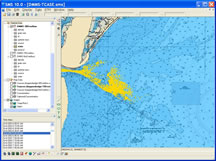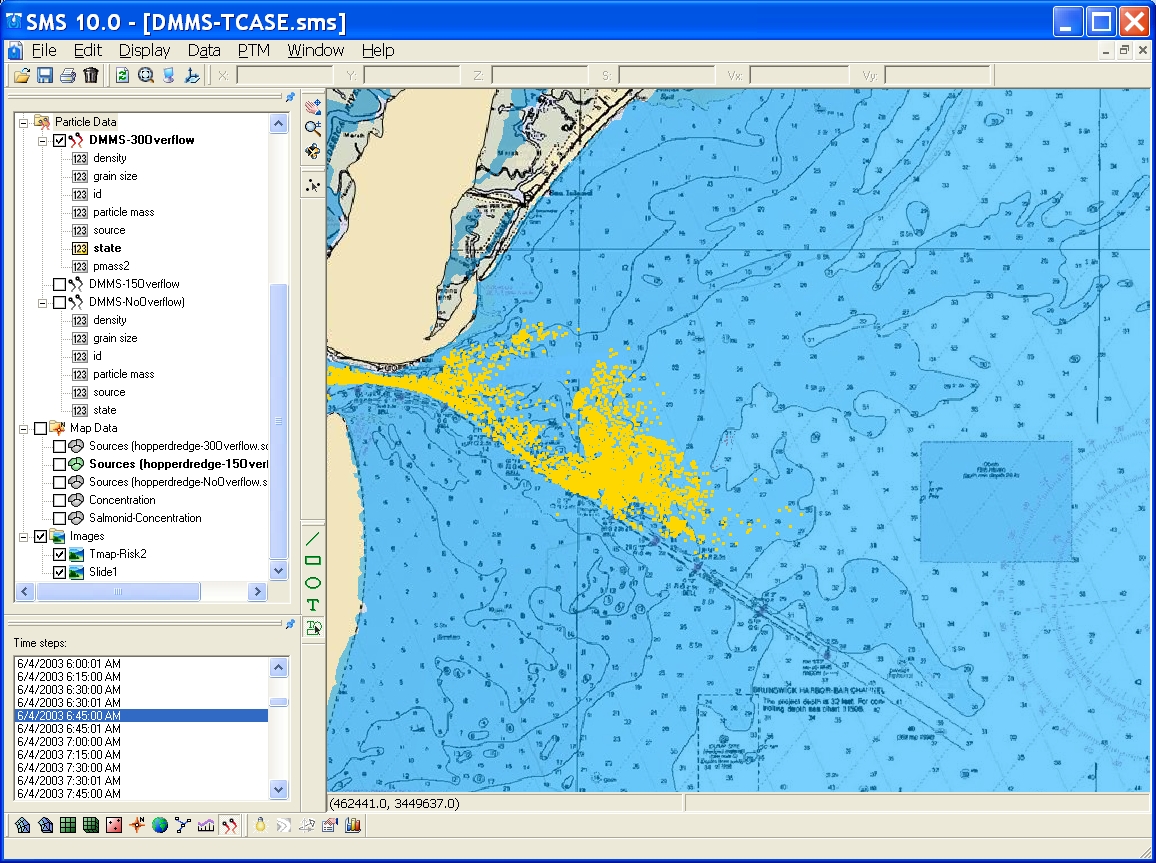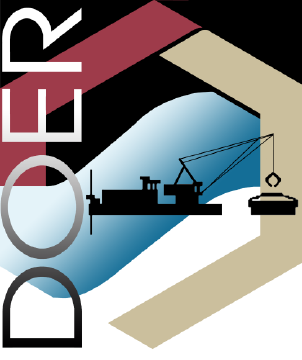Particle Tracking Model
Introduction
The Particle Tracking Model (PTM) is a Lagrangian particle tracker designed to allow the user to simulate particle transport processes. PTM has been developed for application to dredging and coastal projects including dredged material dispersion and fate, sediment pathway and fate, and constituent transport. The model contains algorithms that appropriately represent transport, settling, deposition, mixing, and resuspension processes in nearshore wave/current conditions. It uses waves and currents developed through other models and input directly to PTM as forcing functions. PTM Version 2.0 operates in the Surface-water Modeling System (SMS) interface (v10.1). The model is funded through two ERDC research programs, the Coastal Inlets Research Program (CIRP) and the Dredging Operations and Environmental Research (DOER) Program.


Points of Contact
DOER Contact:
- DOER Contact:
- >> Tahirih Lackey
- Coastal and Hydraulics Laboratory
- Engineer Research and Development Center
- 3909 Halls Ferry Rd. Vicksburg, Mississippi 39180
- Voice: (601) 634-3552
- Fax: (601) 634-4314
CIRP Contact:
- CIRP Contact:
- >> Honghai Li
- Coastal and Hydraulics Laboratory
- Engineer Research and Development Center
- 3909 Halls Ferry Rd. Vicksburg, Mississippi 39180
- Voice: (601) 634-2840
Fact Sheet and More Information
PTM Fact Sheet
Articles
- Lackey, T. C., S. Bailey, J. Z. Gailani, S-C. Kim, and P. Schroeder. (2019). “Hydrodynamic and Sediment Transport Modeling for James River Dredged Material Management,” ERDC/CHL Technical Report (ERDC/CHL TR-20-21), Coastal and Hydraulics Laboratory (U.S.) Engineer Research and Development Center (U.S.). https://hdl.handle.net/11681/38255
- Li, H., T. C. Lackey, T. M. Beck, H. R. Moritz, K. C. Groth, T. Puckette, and J. Marsh. (2018). “Field Measurements, Sediment Tracer Study, and Numerical Modeling at Coos Bay Inlet, Oregon,” ERDC/CHL Technical Report (ERDC/CHL TR-18-6), Coastal and Hydraulics Laboratory (U.S.) Engineer Research and Development Center (U.S.). https://hdl.handle.net/11681/27606
- Shafer, D., J. McManus, R. Richmond, D. King, J. Z. Gailani, T. C. Lackey, D. Bryant. (2016). Predicting dredging-associated effects to coral reefs in Apra Harbor, Guam - Part 2: Potential coral effects. Journal of environmental management. 168. 111-122. https://dx.doi.org/10.1016/j.jenvman.2015.10.025
- Gailani, J. Z., T. C. Lackey, D. B. King, D. Bryant, S-C. Kim, and D. J. Shafer. (2016). Predicting Dredging-Associated Effects to Coral Reefs in Apra Harbor, Guam—Part 1: Sediment Exposure Modeling. Journal of Environmental Management. 168: 16–6. https://doi.org/10.1016/j.jenvman.2015.10.027
- Demirbilek, Z., T. C. Lackey, and A. K. Zundel. (2012). “Particle Tracking Model Data Analysis Tools – Part 2: Capabilities in SMS,” DOER Technical Notes Collection (ERDC TN-DOER-D16), U.S. Army Engineer Research and Development Center, Dredging Operations and Environmental Research Program. https://hdl.handle.net/11681/8621
- Demirbilek, Z., T. C. Lackey, and A. K. Zundel. (2012). “Particle Tracking Model Data Analysis Tools – Part 1: Capabilities in SMS,” DOER Technical Notes Collection (ERDC TN-DOER-D15), U.S. Army Engineer Research and Development Center, Dredging Operations and Environmental Research Program. https://hdl.handle.net/11681/8619
- Lackey, T. C., S-C. Kim, and D. G. Clarke. (2009). “ASSESSMENT OF DREDGING-INDUCED SEDIMENTATION ON WINTER FLOUNDER SPAWNING HABITAT”. Link to PDF
- Lackey, T. C. and S. J. Smith. (2008). “APPLICATION OF THE PARTICLE TRACKING MODEL TO PREDICT THE FATE OF DREDGED SUSPENDED SEDIMENT AT THE WILLAMETTE RIVER.” Link to PDF
- Gailani, J. Z., T. C. Lackey, and S. J. Smith. (2007). “APPLICATION OF THE PARTICLE TRACKING MODEL TO PREDICT FAR-FIELD FATE OF SEDIMENT SUSPENDED BY NEARSHORE DREDGING AND PLACEMENT, BRUNSWICK GA.” Link to PDF
- Lackey, T. C. and N. MacDonald. (2007). “THE PARTICLE TRACKING MODEL: DESCRIPTION AND PROCESSES”. Link to PDF
- MacDonald, N. J. , M. H. Davies, A. K. Zundel, J. D. Howlett, Z. Demirbilek, J. Z. Gailani, T. C. Lackey, and S. J. Smith. (2006). “PTM: Particle Tracking Model; Report 1: Model Theory, Implementation, and Example Applications,” ERDC/CHL Technical Report (ERDC/CHL TR-06-20), Coastal and Hydraulics Laboratory (U.S.) Engineer Research and Development Center (U.S.). https://hdl.handle.net/11681/7695
- Demirbilek, Z., S. J. Smith, A. K. Zundel, R. D Jones, N. J. McDonald, and M.E. Davies. (2005). “Particle Tracking Model (PTM) in the SMS: III. Tutorial with examples,” DOER Technical Notes Collection (ERDC TN-DOER-D6), U.S. Army Engineer Research and Development Center, Dredging Operations and Environmental Research Program. https://hdl.handle.net/11681/8722
- Davies, M. H., N. J. McDonald, Z. Demirbilek, S. J. Smith, Z. K. Zundel, and R. D. Jones. (2005). “Particle Tracking Model (PTM) II: Overview of features and capabilities,” DOER Technical Notes Collection (ERDC TN-DOER-D5), U.S. Army Engineer Research and Development Center, Dredging Operations and Environmental Research Program. https://hdl.handle.net/11681/8725
For detailed information about the Particle Tracking Model interface visit the SMS:PTM Wiki.
